

Certificación de la Competencia Digital Docente: propuesta para el profesorado universitario. En la evolución constante de la educación, es incuestionable la cada vez mayor influencia de las Tecnologías de la Información y la Comunicación, hecho que determina el interés creciente en la competencia digital del profesorado en todos los niveles del sistema educativo.
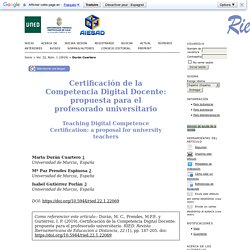
Las universidades no escapan a esta realidad: “Ante la revolución tecnológica, la universidad se comporta como cualquier otra organización de nuestro tiempo. No puede ignorarla y dejar de aprovechar todos sus beneficios” (Marcovitch, 2002, p. 87). El Big Data y la IA: ¿Nos aportan un cambio a la educación? ¿Qué dice la investigación sobre el aula invertida? RJ88 07. Learning is the work. Continued from Why do I need KM? … Work is learning and learning is the work. Why? Because the nature of work is changing. For example, automation is replacing most routine work. In complexity, we can determine the relationship between cause and effect only in retrospect. In complex work environments, the optimal way to do work is to constantly probe the environment and test emergent practices. Work in complex situations requires a greater percentage of implicit knowledge, which cannot be easily codified. Effective organizational knowledge-sharing for this new world of work needs individuals who are adept at sense-making.
PKM is a set of processes, individually constructed, to help each of us make sense of our world, and work more effectively. El aprendizaje adaptativo, tecnológico y de datos… lleva al personalizado a procesos metacognitivos y significativos. Addressing the Decline of Open Source LMS for #altc Discussion - PhilOnEdTech. Top 10 Learning Systems for 2019. When ever I travel on an airplane, my typical MO is to get to my seat, turn on my music connect my headphones and ignore the person next to me.
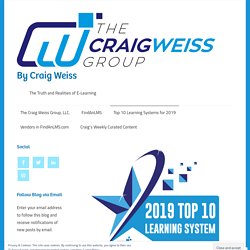
I readily admit this. On my last flight over here to London, I couldn’t do it, because the person started to have a conversation right after I sat down. The downside to this, is I wasn’t able to listen to Death Cab for Cutie (a band), but on the upside, I learned that this person was one of the first 100 employees ever to work at Microsoft. He noted the things he created at the company, who was the guy behind Excel and that everyone was a genius back then. Moodle. There is an old story about branding.
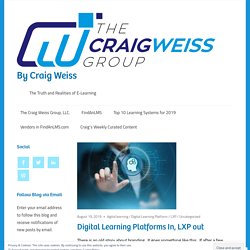
It goes something like this. If after a few years, nobody can recall your name, or remember your name or even associate your name with the type of product you are, then you need to change your name. Actually, it isn’t an old story. I just created it, but it is so true. LXPs have this problem. Moodle. When new ideas boom, bust, then come roaring back: around the U-bend. Lately I’m thinking about the re-emergence of ideas over time.
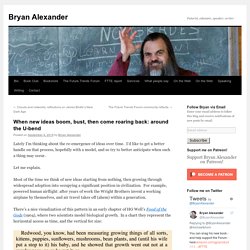
I’d like to get a better handle on that process, hopefully with a model, and so try to better anticipate when such a thing may occur. Let me explain. Most of the time we think of new ideas starting from nothing, then growing through widespread adoption into occupying a significant position in civilization. For example, powered human airflight: after years of work the Wright Brothers invent a working airplane by themselves, and air travel takes off (ahem) within a generation. There’s a nice visualization of this pattern in an early chapter of HG Well’s Food of the Gods (1904), where two scientists model biological growth.
Rethinking the Context of Edtech. The sociology of education technology has encouraged us to emerge from our areas of specialization and work together as a community of practice to reconsider the context of edtech.
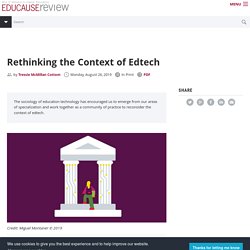
Sociologists specialize in context. We like to describe things, and sometimes we like to predict things. We've done both in the area of education technology ("edtech"). The British sociologist Neil Selwyn first proposed the idea of a sociology of education and technology, and he has been focusing on this issue for at least twenty years.1 Yet in a more recent book chapter, Selwyn and his colleagues noted that most of the research and writing on education technology is somewhat limited in its scope and in its ambition.2 I would put a finer point on that claim.
Google lanza herramienta educativa para combatir el plagio. Google for Education anunció el lanzamiento de una nueva herramienta para promover la originalidad en las tareas y proyectos de los estudiantes, que en realidad luce más como una iniciativa para evitar el plagio en los trabajos escolares.
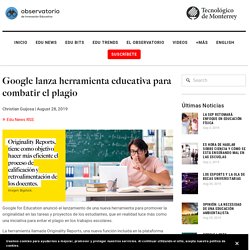
La herramienta llamada Originality Reports, una nueva función incluida en la plataforma Assignments de Google Classroom, tiene como objetivo hacer más eficiente el proceso de calificación y retroalimentación de los docentes, además de promover en los estudiantes mejores prácticas al referenciar el trabajo de otros. Una herramienta eficiente contra el plagio Google sabe que los maestros usan su motor de búsqueda para descubrir trampas en las tareas que califican. Esta práctica común implica copiar y pegar frases de un escrito, y los resultados revelan posibles situaciones de plagio. Bettshow LATAM - Home Page. El renacer de la palabra en un mundo digital. Si el mundo es inabarcable, solo nos queda recorrerlo.

Cualquier intento de vallarlo es trocearlo y reducirlo. Para un mundo ilimitado no hay actitud sedentaria posible, solo la de que cada viaje trace una travesía distinta. 20, núm. 2 (2017) How to Make Your Presentations Accessible to All. Ask speakers and participants if they have accessibility requirements For example, include a question on registration forms for conferences, send an email to company-internal training participants, etc.
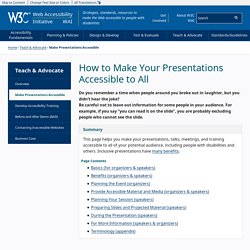
Invite participants to include specific requests. For example, someone who is hard of hearing might request seating small discussion groups in a circle to make it easier to hear people talking. Or someone with low vision might ask to sit in the front row to see the screen better. Ensure the facility and area is accessible to speakers and participants For example, ensure the building entrance, meeting room, presentation stage, and bathrooms are accessible.
Ensure adequate sound system, and arrange for microphones. Temas sobre tecnología educativa. Historical SIS Market for HigherEd Institutions — LISTedTECH. We are happy to present the first version of this historical Student Information Systems graph.

We would like to thank several industry experts who took the time to help us with the creation of the graph. We know (and hope) that many of you will send updates and comments. Since this graph wants to be as geographically inclusive as possible, please share with us any suggestions or additions, even if they only target a continent or sub-region. Please note that this graph does not include very small systems (those that have less than ten clients) as well as systems that target K-12 institutions. This image does not show market share, just historical mergers or acquisitions. Headspring Executive Development by Financial Times and IE Business School. Future Trends in Technology and Education.